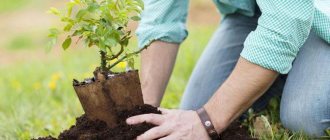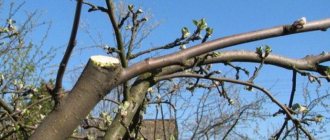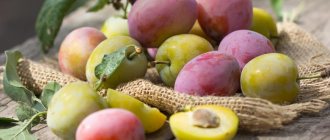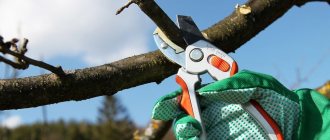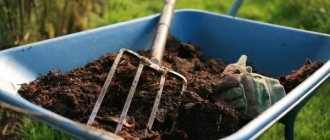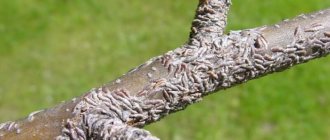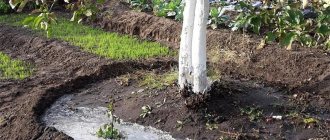Features of planting fruit trees in the Moscow region
The Moscow region is a favorable area for growing fruit trees. The yield level and lifespan of the plant depend on many factors, including weather conditions, terrain, and soil composition.
In order for a tree to bear fruit consistently, it is important to follow the rules of proximity to other crops, patterns and distances between plants. During planting, summer residents follow the recommendations for preparing the planting hole and seedlings. In the Moscow region, trees are planted both in spring and autumn - it depends on the culture.
Dates for autumn planting
The optimal period for planting trees and shrubs is the end of September and all of October. In warm weather it can last until mid-November (southern regions).
Every year the weather is changeable, and planting dates are in the fall.
depend largely on weather conditions.
Important to remember:
The guideline for planting and transplanting seedlings is the dormant period of plants, which begins after the end of leaf fall.
Return to contents
Video - When is the best time to plant seedlings of fruit and berry trees?
When is it better to plant - in spring or autumn?
When is it better to plant fruit trees in the Moscow region - in spring or autumn? There is no consensus on this matter. Everything depends on climatic factors. Pay attention to the amount of precipitation, air and soil temperatures, and temperature changes. It is important to remember that the earth must be warmed up; There is no point in planting fruit trees in frozen soil. The seedlings will not take root or will often get sick.
Advantages and disadvantages of spring planting
In spring, plants are planted immediately after the snow melts. Delay in this matter is unacceptable: if you miss the due date, the amount of growth decreases and fruiting is delayed. This is the main disadvantage of spring planting.
In the spring, heat-loving trees are planted - peach, apricot, cherry. They need time to adapt to climatic conditions. If you plant them in the fall, there is a high risk of winter frost. It is also convenient that the planting hole is prepared for spring before winter; After the snow melts, all that remains is to prepare the seedlings and send them into the ground.
Also in the spring, summer residents have the opportunity to quickly respond to changes occurring with seedlings. For example, monitor their development and carry out preventive measures to protect against diseases and pests. And the spring supply of water in the soil has a positive effect on growth.
Pros and cons of autumn planting
In autumn, plum, apple, pear and quince trees are planted. Plants have time to take root before the onset of frost, and under the snow cover they gain strength for further development. One of the advantages is that in the fall there is a wider choice of different varieties of fruit trees. Vienna does not have such diversity.
However, autumn planting is not suitable for heat-loving plants. At this time, summer residents use seedlings with closed roots or container planting material. The roots must be in perfect condition, otherwise poor survival rate is guaranteed.
Preparing planting holes
We prepare the planting hole in advance in compliance with the required dimensions
The most optimal solution is when the holes for planting are prepared in advance, i.e. if planting is planned in the spring, the hole is prepared in the fall; for autumn planting, preparations begin in the spring season.
If the deadlines are missed, the formation of holes is possible half a month before planting. During this time, the soil will subside and all empty spaces that could cause root rot will disappear.
All types of fruit crops and fruit and berry bushes begin to vary in size with age (2-3 years). For this reason, the size of the prepared holes for each type is different:
| Planting material | Depth, cm | Diameter, cm |
| Pome type with bare rhizome | 60 | 90-100 |
| Stone fruit type and shrubs | 40-50 | 75-80 |
| Closed root material | 60-80 | 100 |
In order for the seedling to begin to bear fruit faster, the hole for it must be wide and shallow.
Planting fruit trees
Holes about 1 m wide and 60-80 cm deep are made in areas where the soil is heavy, because nutrients (the main part of them) are located in the surface layer, the most fertile . If the roots are too deep, the tree will not be able to feed and adapt normally.
The process of digging a hole:
1 A peg is driven into the central part of the proposed hole, onto which a cord with a metal rod is tied. They will draw the required circle
2Digging a hole
3The excavated soil is laid out on different sides: in the 1st - the upper dark fertile layer, in the 2nd - the lower lighter layer
4If necessary, the surface layer is adjusted: to heavy soil - add 1 bucket (partial) of sand, to light soil - chernozem or soil from the garden, diluted in equal proportions with peat
5Acidic soil, 10-15 days. Before planting the tree, it is limed with dolomite flour or chalk. Fertilizer is applied when planting
How to choose the right time for planting
To plant any fruit trees, above-zero temperatures are required. For the Moscow region this is from +5°C and above. It is important to make sure that frosts have passed (if we are talking about planting in the spring) or have not yet occurred (if we are talking about autumn planting).
Choosing a period depending on the fruit tree
When choosing a planting date, gardeners take into account the type of tree. Apple and pear trees are planted in mid or late April, peaches and apricots - from September 5 to 15.
Sweet cherries are planted in the first ten days of October, plums - at the end of September or mid-April.
Attention! The determining factor when choosing is air temperature and precipitation. Even if according to the calendar the time is right, but frost has already set in or, conversely, the snow has not melted yet, it is better to postpone the procedure and wait for favorable days.
Calculation according to the lunar calendar
The development of plants is influenced not only by the phase of the Moon, but also by its location in the sky. It is generally accepted that the Moon, being in a certain zodiac sign, affects different parts of the plant: leaves, roots, stems, trunk, shoots, fruits. Therefore, some summer residents carry out all agrotechnical activities in accordance with the state of the Moon on a given day. Information about this is contained in the lunar calendar.
The following dates are chosen for planting fruit trees and shrubs in 2021:
- apple tree: 8-9, 21-23, 31 May; September 8-9, 13-14, 18-19,22-24; October 15-16, 20-21;
- quince and pear: 8-9, 17-18, 21-23, 31 May; September 3-4, 8-9, 22-24; October 15-16, 20-21;
- apricot, plum, cherry plum: August 21-27; September 8-9, 18-19; October 15-16, 20-21;
- peach, cherry: 8-9, 20-23, 31 May; August 9-13, 21-27; September 22-24; November 16-17.
Advantages and pitfalls of autumn fruit planting
Experienced gardeners are equally successful in planting fruit crops in autumn and spring. Still, autumn planting is preferable for a number of reasons:
- In the fall there is always a huge selection of good seedlings on sale, and the health of the seedling can be assessed by the condition of the roots;
- It is easier to plant fruit trees and shrubs in the fall, and usually one watering is enough, then the rains begin;
- The root system of a planted fruit plant will develop in the fall until the temperature drops to +4 degrees;
- All major pests are already preparing for hibernation during autumn planting, so they will not cause any damage to young plants;
- Seedlings take root in the fall, so in the spring they immediately begin to develop rapidly and are superior to spring seedlings in everything. In addition, young plants harden over the winter and tolerate temperature changes and recurrent frosts much better than spring plants.
In the middle zone and in the northern regions, you can also plant fruit trees and fruit bushes in the fall, but the seedlings will need to be hilled up before winter.
The danger of autumn planting is that the seedling may freeze in winter. But this only happens if the gardener has made serious mistakes:
- landing incorrectly;
- an unacceptable variety in this region (southern) was planted;
- low quality seedling with frozen or dried roots;
- the crop was planted before the dormant period began.
And most importantly, fruit seedlings can be planted only during the dormant period. In the spring it is very short, from the moment the soil thaws until the sap begins to flow, and in the fall it is much longer - after the leaves fall, until the plants go into hibernation.
Sadovnik62 Consultant FORUMHOUSE
The plant is least susceptible to winter hardships when at rest.
Conditions for planting seedlings
An important condition is a suitable place for growing. Before planting several fruit trees at once, summer residents draw up a plan in which they indicate the height of the trees and the degree of shading of other crops, the type of tree crown, and the period of fruit ripening. It is important that the plants do not shade each other. If the trees are tall, the distance between them should be at least 5 m, if dwarf - at least 3 m.
The area for the tree should be spacious and well lit. A plant with a thick and voluminous crown is planted away from the fence and garden buildings. If the tree is small, several specimens will make an attractive hedge or landscape design element.
There should be no groundwater or swampy areas near the growing site. The root system of most trees does not tolerate waterlogging, so it is better to resolve this issue in advance. A suitable location is hilly and windless, located on the south side of the garden plot.
Tree replanting
Fruit trees are replanted at any time of dormancy - after dropping their leaves in the fall or before the buds open in the spring. It is recommended to replant plants that are at least 20 years old. A common method of transplantation is with an earthen ball. With its help, the plant is less injured and begins to bear fruit faster in a new place. The shape of the coma should be in the form of a cylinder or cube. The procedure is simple: a groove is dug around the trunk at a distance of 50 cm and all horizontal roots are cut off. Then humus is added to the groove.
When transplanting, the tree is removed along with the ground; a tractor or drag sheets are used for this. The plant is placed in a pre-prepared planting hole and watered abundantly. One adult tree requires about 25 liters. In the first year after transplantation, fertilizer is not required. If the plant is damaged during the procedure, apply fertilizer based on ammonium nitrate - 5 g of the substance per 10 liters of water.
How to plant fruit trees in spring
Spring planting of fruit trees is no different from autumn. Planting of seedlings is carried out pointwise or in groups. This must be done at intervals so that neighboring trees do not compete with each other. You should also take into account the composition of the soil, the level of groundwater, the proximity of buildings, structures, and structures.
Site selection
As a rule, well-lit areas protected from cold winds are chosen for planting fruit trees. They are often planted on the south side of houses or fences. For large gardens, it is advisable to use southern slopes of hills. Fruit trees do not tolerate stagnation of water in the roots, so they are not planted on wetlands or flooded lands, as well as in areas where groundwater comes close to the surface.
Preparing the planting hole
The size of the planting hole is determined by the size of the seedling's root system. Typically, a depth of 0.6–0.8 m and a diameter of 0.5 m is sufficient. Preparation of planting holes for spring planting of fruit trees is carried out in the fall. This allows the soil inside the hole to be saturated with air. The soil removed from the hole is mixed in a 1 to 1 ratio with humus, and the following fertilizers are also added:
- urea - 1 tbsp. l.;
- superphosphate – 1 tbsp. l.;
- wood ash - 1 tbsp.
The ingredients are thoroughly mixed together. This nutrient soil will then be used to plant seedlings.
If there is a risk of raising the groundwater level, a layer of expanded clay, broken brick or crushed stone is poured onto the bottom of the planting hole for drainage. A mound of nutrient soil is poured on top to about 1/3 of the depth. The planting holes are left in this state until spring. Before planting, a peg is driven into the bottom near the center of the hole, to which the tree will be tied after planting.
At what distance to plant fruit trees and shrubs?
It is important that trees do not compete with or shade each other as they grow. Therefore, the distance between neighboring tree seedlings should be at least 2.5-3 m, and shrubs – at least 1.5 m. They should be planted at the same distance from the walls of houses or buildings, otherwise in the future an adult tree’s roots may damage the foundation.
Seedling care
After planting, fruit tree seedlings need good care. It is important to ensure that the soil underneath does not dry out. This requires regular watering, as well as mulching the soil with a layer of peat or humus. The bright sun has a negative effect on newly planted plants, so at first they are shaded. To prevent wind damage in the first years of life, young trees are tied to a support.
Immediately after planting, the fruit tree seedling is pruned, thus beginning to form its future crown. Depending on the type chosen, the cutting height may vary. For example, when forming a sparsely-tiered crown, the seedling is cut at a height of approximately 0.8 m from the grafting level; to establish a cup-shaped or bush crown - 0.5–0.7 m.
Bad and good neighborhood for fruit trees
To increase the yield of fruit trees, it is recommended to pay attention to their compatibility. During the development process, plants release biological components into the air that affect the fruiting of a number of growing crops. For example, a pear gets along well with an apple tree, but does not coexist well with quince, cherry, sweet cherry, peach, plum, and apricot.
Neighborhood examples:
- peach takes root with an apple tree, but does not take root with a pear, cherry, plum;
- the apple tree is unpretentious, takes root with rowan, cherry, pear, unfavorable neighbors - viburnum, cherry;
- plum takes root with cherries, cherry plums and sweet cherries, but does not fit well with pears.
Preparatory stage
The preparation stage begins with the selection of seedlings. They must be healthy and strong, with a trunk thickness of 2-3 cm and skeletal branches 45 cm long. When purchasing, the trunk and the condition of the bark are inspected; there should be no traces of insects and pests on it. If seedlings are sold in a container, the roots should be dense and sit firmly inside the container.
Attention! If seedlings are purchased long before planting, wrap the roots in a damp cloth and put the plant in a cool and dark place. This is necessary in order to prevent the root system from drying out. Before planting, weak roots are removed, and the remaining ones are soaked in the growth stimulator “Kornevin”. From the container, the seedlings are moved into the planting hole along with a lump of earth.
For planting, prepare holes with a depth of about 80 cm and a diameter of 1 m. The earth is dug up, a mixture of compost or humus (2-3 buckets), peat chips (3-4 buckets), 1 kg of superphosphate and 1 kg of ash is added to the hole. A stake is driven in the middle of the hole for support. To improve the nutritional properties, the top layer of soil is set aside and the dug hole is covered with earth mixed with sand, turf and peat.
Spring planting of trees and shrubs: important secrets
The root collar of trees should not be completely covered with soil. Leave it at least 3 cm above the ground level.
It is advisable to tie all young trees, even in areas with no wind, to pegs. In this case, the landing occurs on the north side of the peg. Several support pegs are also used at the same time, especially in areas with a draft or in open areas.
The distance between fruit trees when planting varies depending on the type and variety. The main criterion is the decay of the crown and root system of the plant. It is necessary to give the opportunity to grow normally, without interfering with each other by shading and lack of nutrients in the soil.
Like regular fruit crops, if there are problems on the trunk or foliage, columnar apple and pear trees will require spraying with insecticides for fruit trees. The best choice against sucking and leaf-eating pests would be Confidor Extra.
After planting, the tree must be trimmed by a quarter to balance the moisture needs of the root system and trunk. The soil near the plant should not be trampled. This damages the roots. It is better to add soil mixture during watering, then the voids near the rhizome will disappear.
Feeding of fruit tree seedlings is carried out already 2 years after planting, provided that fertilizers are used in the planting hole. It is produced regularly in the spring - with nitrogenous fertilizers, in the autumn - with mineral fertilizers.
Correct landing algorithm
How to plant a tree correctly? Experienced gardeners recommend following the following algorithm:
- After preparing the hole, the seedling is placed in the hole, the roots are straightened, and the central root is placed vertically. Pay attention to ensure that there are no bends or creases in the roots.
- The soil is sprinkled between the roots, shaking the plant periodically.
- The soil is compacted so that there are no air pockets or voids.
- It is recommended to plant trees with an assistant: one holds the plant, the other sprinkles it with soil.
- A small mound is made on the surface of the pit so that the earth will settle later.
- Water the plant with 2-3 liters of water, having previously prepared a ditch near the tree trunk.
- The area is mulched with sawdust and peat chips. Mulch retains moisture and helps the plant quickly adapt to its growing location.

